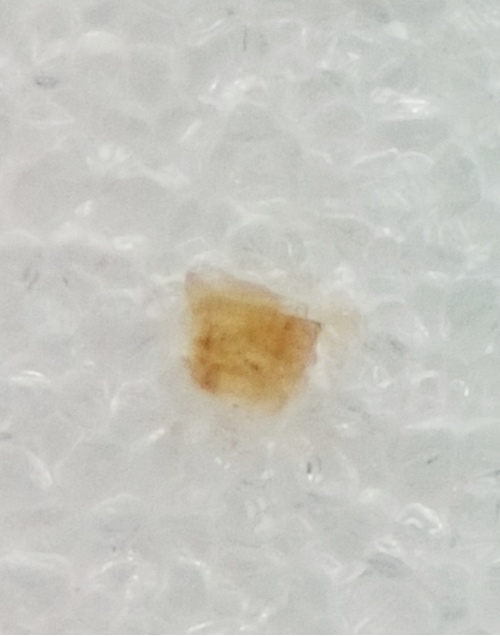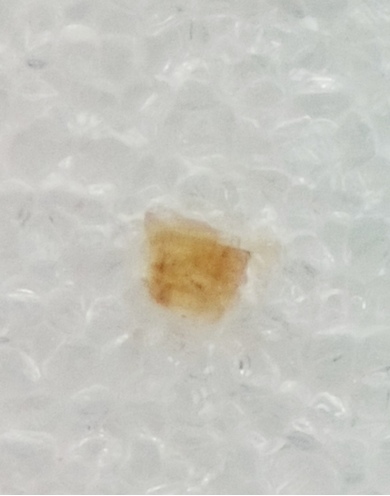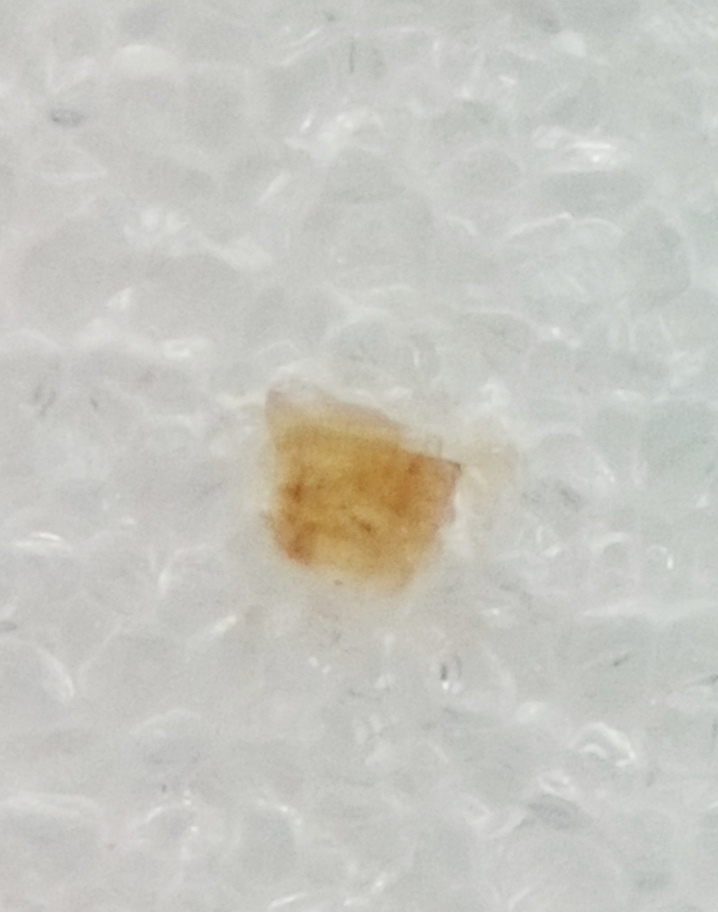Alsakharovite-Zn
A valid IMA mineral species
This page is currently not sponsored. Click here to sponsor this page.
About Alsakharovite-Zn
Formula:
NaSrKZn(Ti,Nb)4(Si4O12)2(O,OH)4 · 7H2O
Colour:
White, light brown, colourless
Lustre:
Vitreous
Hardness:
5
Specific Gravity:
2.9
Crystal System:
Monoclinic
Member of:
Name:
Named in honor of Aleksey Sergeyevich Sakharov (Алексей Сергеевич Сахаров) (18 March 1910 - 16 February 1996, Russia), geologist at the Kola Branch of the USSR Academy of Sciences, who worked on the Lovozero massif. The suffix denotes the dominant extra-framework cation, following the IMA recommended nomeclature for labuntsovite-group minerals.
Gutkovaite structural type.
Unique Identifiers
Mindat ID:
26417
Long-form identifier:
mindat:1:1:26417:2
GUID
(UUID V4):
(UUID V4):
f124185a-0f67-4edc-b20e-453474a7c475
IMA Classification of Alsakharovite-Zn
Approved
IMA Formula:
NaSrKZn(Ti,Nb)4(Si4O12)2(O,OH)4 · 7H2O
Approval year:
2002
First published:
2003
Type description reference:
Classification of Alsakharovite-Zn
9.CE.30h
9 : SILICATES (Germanates)
C : Cyclosilicates
E : [Si4O12]8- 4-membered single rings (vierer-Einfachringe), without insular complex anions
9 : SILICATES (Germanates)
C : Cyclosilicates
E : [Si4O12]8- 4-membered single rings (vierer-Einfachringe), without insular complex anions
Mineral Symbols
As of 2021 there are now IMA–CNMNC approved mineral symbols (abbreviations) for each mineral species, useful for tables and diagrams.
| Symbol | Source | Reference |
|---|---|---|
| Ask-Zn | IMA–CNMNC | Warr, L.N. (2021). IMA–CNMNC approved mineral symbols. Mineralogical Magazine, 85(3), 291-320. doi:10.1180/mgm.2021.43 |
Physical Properties of Alsakharovite-Zn
Vitreous
Transparency:
Transparent, Translucent
Colour:
White, light brown, colourless
Streak:
White
Hardness:
5 on Mohs scale
Cleavage:
None Observed
Fracture:
Irregular/Uneven
Density:
2.9 g/cm3 (Measured) 2.94 g/cm3 (Calculated)
Optical Data of Alsakharovite-Zn
Type:
Biaxial (+)
RI values:
nα = 1.680(1) nβ = 1.687(2) nγ = 1.787(5)
2V:
Measured: 25° (10), Calculated: 31°
Max Birefringence:
δ = 0.107

Image shows birefringence interference colour range (at 30µm thickness)
and does not take into account mineral colouration.
and does not take into account mineral colouration.
Surface Relief:
High
Dispersion:
None
Optical Extinction:
Y = b.
Pleochroism:
Non-pleochroic
Chemistry of Alsakharovite-Zn
Mindat Formula:
NaSrKZn(Ti,Nb)4(Si4O12)2(O,OH)4 · 7H2O
Crystallography of Alsakharovite-Zn
Crystal System:
Monoclinic
Class (H-M):
m - Domatic
Space Group:
Bm
Setting:
Cm
Cell Parameters:
a = 14.495 Å, b = 13.945 Å, c = 7.838 Å
β = 117.75°
β = 117.75°
Ratio:
a:b:c = 1.039 : 1 : 0.562
Unit Cell V:
1402 ų
Z:
2
Morphology:
Flattened prismatic crystals elongated along [010].
Twinning:
Microtwinned on (001) and (401).
Crystal Structure
Load
Unit Cell | Unit Cell Packed
2x2x2 | 3x3x3 | 4x4x4
Unit Cell | Unit Cell Packed
2x2x2 | 3x3x3 | 4x4x4
Show
Big Balls | Small Balls | Just Balls | Spacefill
Polyhedra Off | Si Polyhedra | All Polyhedra
Remove metal-metal sticks
Big Balls | Small Balls | Just Balls | Spacefill
Polyhedra Off | Si Polyhedra | All Polyhedra
Remove metal-metal sticks
Display Options
Black Background | White Background
Perspective On | Perspective Off
2D | Stereo | Red-Blue | Red-Cyan
Black Background | White Background
Perspective On | Perspective Off
2D | Stereo | Red-Blue | Red-Cyan
View
CIF File Best | x | y | z | a | b | c
CIF File Best | x | y | z | a | b | c
Rotation
Stop | Start
Stop | Start
Labels
Console Off | On | Grey | Yellow
Console Off | On | Grey | Yellow
Data courtesy of the American Mineralogist Crystal Structure Database. Click on an AMCSD ID to view structure
| ID | Species | Reference | Link | Year | Locality | Pressure (GPa) | Temp (K) |
|---|---|---|---|---|---|---|---|
| 0018493 | Alsakharovite-Zn | Rozenberg K A, Rastsvetaeva R K, Pekov I V, Chukanov N V (2002) New Zn-rich representative of the labuntsovite group: crystal structure and microtwinning Doklady Chemistry 383 110-113 | 2002 | Lovozero alkaline massif, Kola Peninsula, Russia | 0 | 293 |
CIF Raw Data - click here to close
X-Ray Powder Diffraction
Powder Diffraction Data:
| d-spacing | Intensity |
|---|---|
| 6.96 Å | (100) |
| 3.11 Å | (90) |
| 3.21 Å | (80) |
| 2.50 Å | (40) |
| 1.70 Å | (40) |
| 2.60 Å | (35) |
| 1.74 Å | (30) |
Geological Environment
Paragenetic Mode(s):
| Paragenetic Mode | Earliest Age (Ga) |
|---|---|
| Stage 4b: Highly evolved igneous rocks | >3.0 |
| 35 : Ultra-alkali and agpaitic igneous rocks |
Type Occurrence of Alsakharovite-Zn
General Appearance of Type Material:
Coarse, flattened-prismatic crystals up to 8 x 2 x 0.5 mm.
Place of Conservation of Type Material:
Fersman Mineralogical Museum, Russian Academy of Sciences, Moscow, Russia.
Geological Setting of Type Material:
Hydrothermal mineral found in cavities of eudialyte-aegirine-feldspar pegmatite in an alkaline massif.
Associated Minerals at Type Locality:
Reference:
Pekov, I.V., N.V. Chukanov, A.E. Zadov, K.A. Rozenberg, R.K. Rastsvetaeva (2003) Alsakharovite-Zn, NaSrKZn(Ti,Nb)4(Si4O12)2(O,OH)4·7 H2O, a new mineral of the labuntsovite group from Lovozero massif, Kola Peninsula: Zapiski Vserossiyskogo Mineralogicheskogo Obshchestva (and Zapiski Vsesoyuznogo Mineralogicheskogo Obshchestva): 132(1): 52-58.
Synonyms of Alsakharovite-Zn
Other Language Names for Alsakharovite-Zn
Relationship of Alsakharovite-Zn to other Species
Member of:
Other Members of this group:
| Gutkovaite-Mn | K2CaMn(Ti,Nb)4(Si4O12)2(O,OH)4 · 5H2O | Mon. m : Bm |
| Neskevaaraite-Fe | K3Na2Fe2+(Ti,Nb)4(Si4O12)2(O,OH)4 · 5-6 H2O | Mon. m : Bm |
Related Minerals - Strunz-mindat Grouping
| 9.CE. | Dutkevichite-(Ce) | NaZnBa2Ce2Ti2Si8O26F · H2O |
| 9.CE. | Niobobaotite | Ba4(Ti2.5Fe2+1.5)Nb4Si4O28Cl |
| 9.CE.05 | Papagoite | CaCu[H3AlSi2O9] |
| 9.CE.10 | Verplanckite | Ba4Mn2+2Si4O12(OH,H2O)3Cl3 |
| 9.CE.15 | Baotite | Ba4(Ti,Nb,W)8O16(SiO3)4Cl |
| 9.CE.20 | Nagashimalite | Ba4(V,Ti)4B2Si8O27(O,OH)2Cl |
| 9.CE.20 | Taramellite | Ba4(Fe3+,Ti,Fe2+,Mg)4(B2Si8O27)O2Clx |
| 9.CE.20 | Titantaramellite | Ba4(Ti,Fe3+,Fe2+,Mg)4(B2Si8O27)O2Clx |
| 9.CE.25 | Bario-orthojoaquinite | (Ba,Sr)4Fe2Ti2[Si4O12]2O2 · H2O |
| 9.CE.25 | Byelorussite-(Ce) | NaBa2Ce2MnTi2[Si4O12]2O2(F,OH) · H2O |
| 9.CE.25 | Joaquinite-(Ce) | NaBa2Ce2FeTi2[Si4O12]2O2(OH,F) · H2O |
| 9.CE.25 | Orthojoaquinite-(Ce) | NaBa2Ce2FeTi2[Si4O12]2O2(O,OH) · H2O |
| 9.CE.25 | Strontiojoaquinite | Sr2Ba2(Na,Fe)2Ti2[Si4O12]2O2(O,OH)2 · H2O |
| 9.CE.25 | Strontio-orthojoaquinite | (Na,Fe)2Sr2Ba2Ti2[Si4O12]2O2(O,OH)2 · H2O |
| 9.CE.25 | Orthojoaquinite-(La) | NaBa2La2Fe2+Ti2[Si4O12]2O2(O,OH) · H2O |
| 9.CE.30a | Unnamed (Ca-Na-ordered analogue of Korobitsynite) | (Ca,Na)2(Ti,Nb)2(Si4O12)(OH,O)2 · 3-4H2O |
| 9.CE.30e | Labuntsovite-Mn | Na4K4(Ba,K)2Mn2+(Ti,Nb)8(Si4O12)4(O,OH)8 · 10-12H2O |
| 9.CE.30a | Nenadkevichite | (Na,◻)8Nb4(Si4O12)2(O,OH)4 · 8H2O |
| 9.CE.30d | Lemmleinite-K | K2(Ti,Nb)2(Si4O12)(OH,O)2 · 4H2O |
| 9.CE.30a | Korobitsynite | Na2(Ti,Nb)2(Si4O12)(OH,O)2 · 3-4H2O |
| 9.CE.30c | Kuzmenkoite-Mn | K2Mn2+(Ti,Nb)4(Si4O12)2(OH,O)4 · 5-6H2O |
| 9.CE.30b | Vuoriyarvite-K | K2(Nb,Ti)2(Si4O12)(O,OH)2 · 4H2O |
| 9.CE.30b | Tsepinite-Na | Na2(Ti,Nb)2(Si4O12)(OH,O)2 · 3H2O |
| 9.CE.30c | Karupmøllerite-Ca | (Na,Ca,K)2Ca(Nb,Ti)4(Si4O12)2(O,OH)4 · 7H2O |
| 9.CE.30e | Labuntsovite-Mg | Na4K4(Ba,K)2Mg(Ti,Nb)8(Si4O12)4(O,OH)8 · 10H2O |
| 9.CE.30e | Labuntsovite-Fe | Na4K4(Ba,K)2Fe2+(Ti,Nb)8(Si4O12)4(O,OH)8 · 10H2O |
| 9.CE.30d | Lemmleinite-Ba | Na2K2Ba(Ti,Nb)4(Si4O12)2(O,OH)4 · 5H2O |
| 9.CE.30c | Gjerdingenite-Fe | K2Fe2+(Nb,Ti)4(Si4O12)2(O,OH)4 · 6H2O |
| 9.CE.30h | Neskevaaraite-Fe | K3Na2Fe2+(Ti,Nb)4(Si4O12)2(O,OH)4 · 5-6 H2O |
| 9.CE.30b | Tsepinite-K | K2(Ti,Nb)2(Si4O12)(OH,O)2 · 3H2O |
| 9.CE.30b | Paratsepinite-Ba | Ba4(Ti,Nb)8(Si4O12)4(OH,O)8 · 8H2O |
| 9.CE.30b | Tsepinite-Ca | Ca(Ti,Nb)2(Si4O12)(OH,O)2 · 3H2O |
| 9.CE.30c | Gjerdingenite-Mn | K2Mn2+(Nb,Ti)4(Si4O12)2(O,OH)4 · 6H2O |
| 9.CE.30c | Lepkhenelmite-Zn | (Ba,K)2Zn(Ti,Nb)4(Si4O12)2(O,OH)4 · 7H2O |
| 9.CE.30b | Tsepinite-Sr | Sr(Ti,Nb)2(Si4O12)(OH,O)2 · 3H2O |
| 9.CE.30b | Paratsepinite-Na | (Na,Sr,K,Ca)7(Ti,Nb)8(Si4O12)4(O,OH)8 · nH2O n ~ 8 |
| 9.CE.30f | Paralabuntsovite-Mg | Na8K8Mg4Ti16(Si4O12)8(OH,O)16 · 20-24H2O |
| 9.CE.30c | Gjerdingenite-Ca | K2Ca(Nb,Ti)4(Si4O12)2(O,OH)4 · 6H2O |
| 9.CE.30c | Gjerdingenite-Na | K2Na(Nb,Ti)4(Si4O12)2(OH,O)4 · 5H2O |
| 9.CE.30h | Gutkovaite-Mn | K2CaMn(Ti,Nb)4(Si4O12)2(O,OH)4 · 5H2O |
| 9.CE.30c | Kuzmenkoite-Zn | K2Zn(Ti,Nb)4(Si4O12)2(OH,O)4 · 6-8H2O |
| 9.CE.30g | Organovaite-Mn | K2Mn(Nb,Ti)4(Si4O12)2(O,OH)4 · 5-7H2O |
| 9.CE.30g | Organovaite-Zn | K2Zn(Nb,Ti)4(Si4O12)2(O,OH)4 · 6H2O |
| 9.CE.30g | Parakuzmenkoite-Fe | (K,Ba)4Fe(Ti,Nb)8(Si4O12)4(O,OH)8 · 14H2O |
| 9.CE.30c | Burovaite-Ca | (Na,K)4Ca2(Ti,Nb)8(Si4O12)4(OH,O)8 · 12H2O |
| 9.CE.45 | Komarovite | (Ca,Mn)(Nb,Ti)2[Si2O7](O,F)3 · 3.5H2O |
| 9.CE.45 | Natrokomarovite | (Na,Ca,H)2Nb2Si2O10(OH,F)2 · H2O |
Other Information
Health Risks:
No information on health risks for this material has been entered into the database. You should always treat mineral specimens with care.
Internet Links for Alsakharovite-Zn
mindat.org URL:
https://www.mindat.org/min-26417.html
Please feel free to link to this page.
Please feel free to link to this page.
Search Engines:
External Links:
Mineral Dealers:
References for Alsakharovite-Zn
Reference List:
Chukanov, Nikita V., Pekov, Igor V., Khomyakov, Alexander P. (2002) Recommended nomenclature for labuntsovite-group minerals. European Journal of Mineralogy, 14 (1) 165-173 doi:10.1127/0935-1221/2002/0014-0165
Localities for Alsakharovite-Zn
Locality List
 - This locality has map coordinates listed.
- This locality has map coordinates listed.
 - This locality has estimated coordinates.
ⓘ - Click for references and further information on this occurrence.
? - Indicates mineral may be doubtful at this locality.
- This locality has estimated coordinates.
ⓘ - Click for references and further information on this occurrence.
? - Indicates mineral may be doubtful at this locality.
 - Good crystals or important locality for species.
- Good crystals or important locality for species.
 - World class for species or very significant.
(TL) - Type Locality for a valid mineral species.
(FRL) - First Recorded Locality for everything else (eg varieties).
- World class for species or very significant.
(TL) - Type Locality for a valid mineral species.
(FRL) - First Recorded Locality for everything else (eg varieties).
All localities listed without proper references should be considered as questionable.
Russia (TL) | |
| Pekov et al. (2003) +1 other reference |
| Pekov et al. (2004) |
Quick NavTopAbout Alsakharovite-ZnUnique IdentifiersIMA Classification Classification Mineral SymbolsPhysical Properties Optical Data Chemistry Crystallography Crystal StructureX-Ray Powder DiffractionGeological EnvironmentType Occurrence SynonymsOther LanguagesRelationshipsStrunz-MindatOther InformationInternet Links References Localities Locality List






 symbol to view information about a locality.
The
symbol to view information about a locality.
The 



Lepkhe-Nel'm Mt, Seidozero Lake, Lovozersky District, Murmansk Oblast, Russia